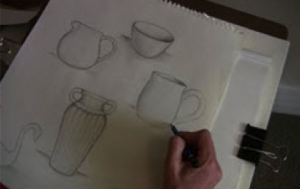I Wish I Could Learn to Draw… But I’m Afraid to Try!
Our reasons for wanting to learn how to draw, or our reasons for not wanting to learn, can be as diverse as we are as individuals! The development of skills associated with drawing and learning to really understand the basic principles of perspective can help us in all of our artistic endeavors. It may be that we want to be able draw out our ideas, or to make things look more realistic, or to improve our ability as a painter. And even if we would just like to be able to draw animals or faces or some other specific thing it still takes starting at the beginning and gradually working towards our goal.
It’s Never Too Late to Learn Drawing
Adults are often afraid to try something new, even when it is something they have always wished they could do. It is not necessarily that we are afraid of failure but sometimes we are convinced we couldn’t ever do it or at least not well enough to satisfy us so we opt to not even try. But the good news is that anyone can learn to draw and it’s never too late to start!
Michelangelo said, “What the eye can see, the hand can draw.” That said, there is what I consider one qualifier: If you can write or print your name legibly along a line on a paper you have enough dexterity and eye hand coordination to draw. The only other thing you really need is desire. Of course paper, pencil and an eraser would also be pretty high on the list of needs and someone knowledgeable to guide you along would also be very helpful.
When we learn how to draw we are interpreting what we observe
“Drawing” and “seeing” are so intertwined that the two can’t really be separated. When we draw we are interpreting what we observe. Developing our observational skills so our brain can tell our hand what to do is one of the most important parts of learning to draw or improving our drawing ability. As we learn and develop greater observation skills we recognize the differences and similarities between things and this is the most important key in learning to draw and in improving our ability to draw.
I have talked to dozens of people who have told me that they have started drawing lessons several times but get discouraged and drop out, or that they’ve bought a few books but couldn’t really work through them on their own. I honestly think that especially as adults we tend to be impatient with ourselves and have unrealistic expectations. I have to laugh when I think of the idea of learning to draw well in just a few weeks. It does take time and practice to develop and improve our skills. If you are a first timer when it comes to learning how to draw you need to allow yourself to start at the very beginning and to actually be a beginner. Yes, it is doable and even YOU can learn to draw but you do need to take the first step¸ practice, and be patient with yourself!
Learn how to draw – Take a Beginning level Drawing class
I currently teach a beginning level Drawing class at the Art Apprentice Online Art School. You can work in privacy at your own speed anytime of the night or day, ask questions and show me your work when you are really ready. Getting critiques is very helpful but whether you want to get them or not is up to you. You have unlimited access to the class materials and because our classes never expire you can go back and review whenever you want. There many video presentations, written lessons that can be printed off with examples and exercises. There are 86 pages of printable materials.
Class Objectives:
- Understand & experience the use of Drawing Materials
- Sharpen one’s ability to see – develop perceptual skills
- Learn to access our creative mode
- Understand, recognize and apply the basic elements of shape
- Learn various methods and techniques for drawing realistically
- Develop and /or improve upon your current drawing ability
Topics covered in Drawing Level I:
- Establish starting ability level (no expectation at all- just a marker)
- Basic Elements of Shape, Line, and Contour
- Observation of space and relationships
- One and two point perspective
- Understanding ellipses
- Structural drawing / shapes / intro to human figure
- Drawing on the picture plane
- Negative & Positive space Drawing
- Sighting / Gauging
- Use of a grid
If you’ve always wanted to give it a try or if drawing is something you are interested in learning…then visit this online drawing class to get started… Sign up – Learn How to Draw Today!


Leave a Reply